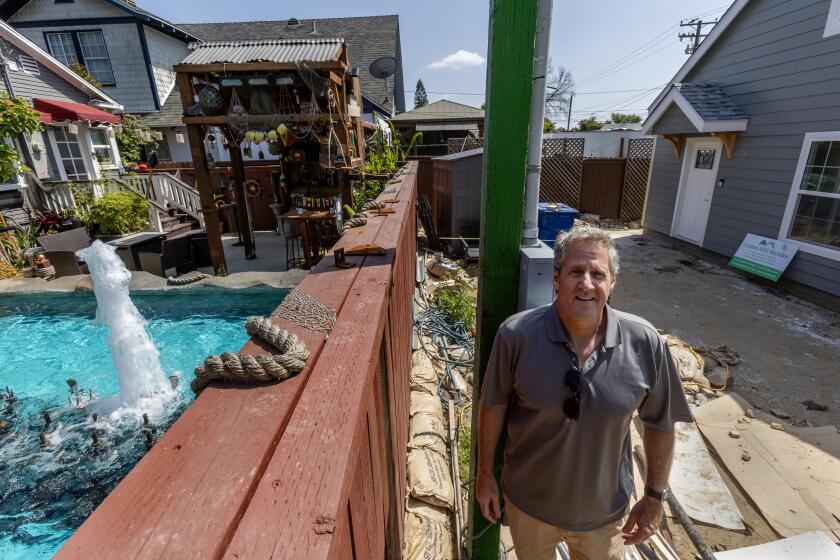A fresh start for Yuma desalting plant
Set amid the wheat fields and melon patches west of downtown, the 60-acre Yuma Desalting Plant is a technological marvel — capable of cleaning 73 million gallons of brackish farm runoff a day, enough for 110 Olympic-sized swimming pools.
FOR THE RECORD:
Desalination plant: An article in Saturday’s LATExtra section about a water desalination plant in Yuma, Ariz., reported that the Metropolitan Water District of Southern California supplies 1.5 billion gallons of water per year to its customers. That figure, given by the Bureau of Reclamation, is the amount provided daily, according to MWD spokesman Bob Muir. —
Built in 1992 at a cost to the federal government of $250 million, the plant was meant to help the U.S. meet its treaty obligations with Mexico involving the Colorado River and to demonstrate how desalination could be a major answer to slaking the growing thirst of Los Angeles, Las Vegas, San Diego and Phoenix.
It hasn’t worked out that way.
For reasons of hydrology and politics, the plant has run for only a few months in all these years — even though it costs about $6 million a year to maintain in “reserve” status. The brickbats from politicians and others have piled up.
“Has it been called a white elephant?” said Pat Mulroy, general manager of the Southern Nevada Water Authority. “You bet it has.”
But this week, Mulroy’s agency, along with the Metropolitan Water District of Southern California and the Central Arizona Project, signed an agreement to underwrite the cost of running the plant in a yearlong pilot project.
If all goes as planned, 29,000 acre-feet of salty water from Arizona farms will be scrubbed through chemicals and filtration and put into the nearby Colorado River as it flows to Mexico. That’s enough water for the annual needs of more than 116,000 people, officials said.
For every acre-foot of water that is cleaned and sent to the river, the three water agencies will be able to take an additional acre-foot from the Colorado River beyond their assured allocations under a welter of agreements known as the Law of the River.
Among other things, the agreement is a renewed indication that the drought gripping the southwestern U.S. has led often-feuding water agencies to embrace cooperation over lawsuits.
“When I was elected 12 years ago, the word ‘cooperation’ was never mentioned,” said Susan Bitter-Smith, president of the Central Arizona Project board of directors.
Mulroy agreed: “The three states spent a lot of time hiring lawyers and fighting each other and not being able to cooperate.”
The desalting project is an outgrowth of a 1944 binational treaty that assures Mexico 1.5 million acre-feet of water each year from the Colorado River. (By comparison, the farmers of the Imperial Valley get more than 3 million.)
In the 1960s the Mexican government began complaining that agricultural runoff into the river near Yuma was making the water too salty.
An amendment was added to the treaty setting salt limits on the Colorado River as it reaches Mexico. Congress authorized building the desalting plant. By some accounts, the major mover behind the project was then-Secretary of State Henry Kissinger as part of his diplomatic overture to Mexico.
By the time the plant was completed in 1992, a 73-mile diversion canal had also been built to keep the farm water runoff out of the Colorado River and take it south to a marshy area in Mexico known as the Cienega de Santa Clara. Also, the early 1990s were exceptionally rainy, diluting the salt from the runoff.
Suddenly the Colorado River water was within the salt limits even without the plant. Critics blasted the desalting plant as not needed, a boondoggle.
The brackish water in the diversion canal — about 110,000 acre-feet a year — was not counted against the Mexican allocation of 1.5 million acre-feet from the Colorado River.
Under the new agreement, the plant will be run at one-third capacity for 365 days in the next 18 months. The desalted water will go into the Colorado River and be counted against the Mexican allocation — allowing the three agencies to divvy up a quantity of water equal to the amount being cleaned.
A separate agreement between the U.S., Mexico and environmental groups on both sides of the border calls for replacement water to be supplied to the Cienega de Santa Clara, which has become a major resting spot for migratory birds. Birders will be watching to measure the effect on the avian community.
The pilot project will cost $23 million. The three water agencies will contribute $14 million; and the U.S. Bureau of Reclamation, which runs the desalting plant, will provide $9 million.
The Metropolitan Water District, which supplies 1.5 billion gallons a year to 19 million people in six Southern California counties, is paying 80% of the $14-million tab for the project and will get 80% of the water. Arizona and southern Nevada will each get 10%.
Whether the project will be renewed after the pilot program is unknown. Water politics in the Southwest are expensive, complex and controversial.
Angela Adams, program analyst for the Yuma office of the Bureau of Reclamation, said she never took criticism of the plant personally. “It’s an issue of unused capacity,” she said.
At the very least, the project may help rehabilitate the reputation of the much-maligned plant.
“That some of the most sophisticated water districts in the country think this plant is worthwhile should count for something,” said Anne Castle, assistant secretary of water and science in the U.S. Department of the Interior.
More to Read
Start your day right
Sign up for Essential California for news, features and recommendations from the L.A. Times and beyond in your inbox six days a week.
You may occasionally receive promotional content from the Los Angeles Times.






